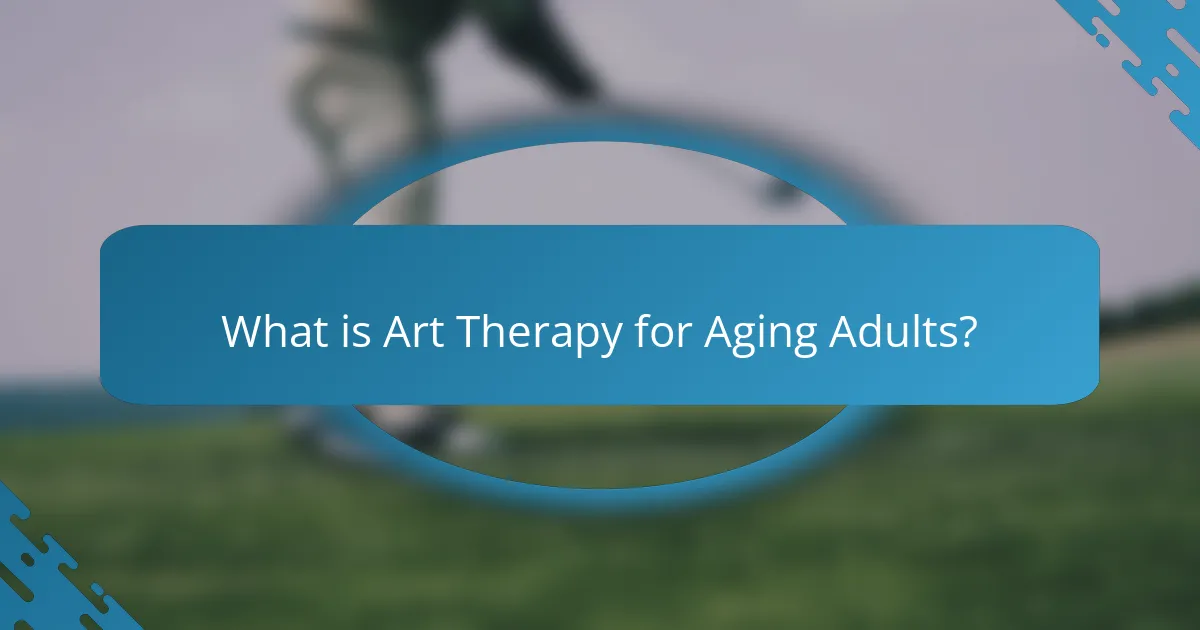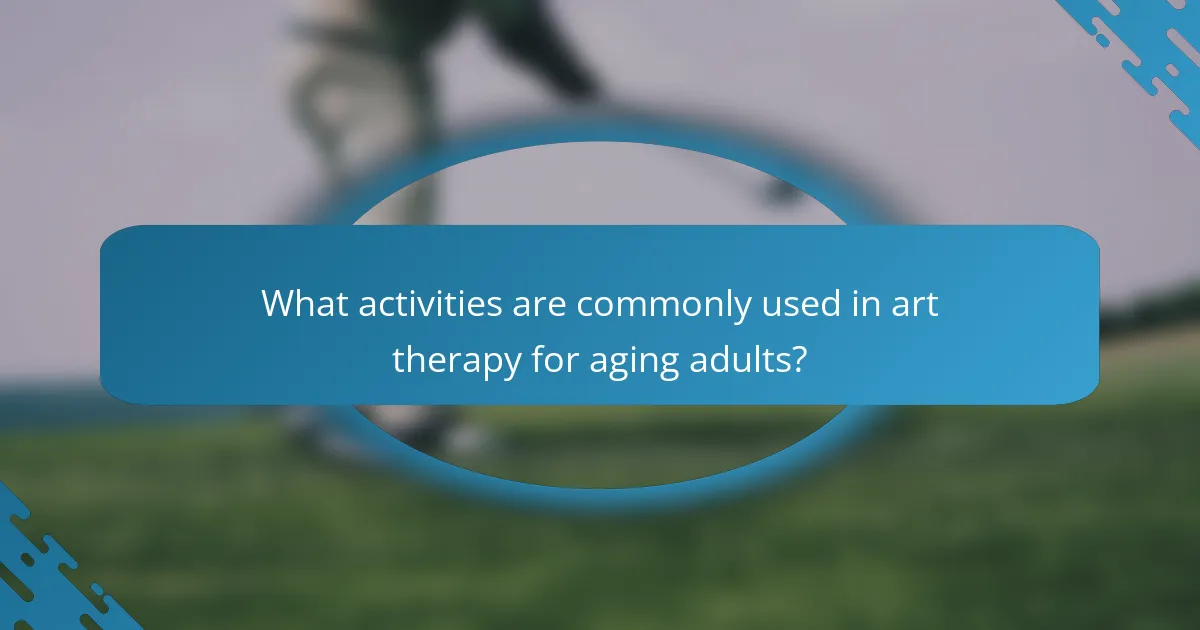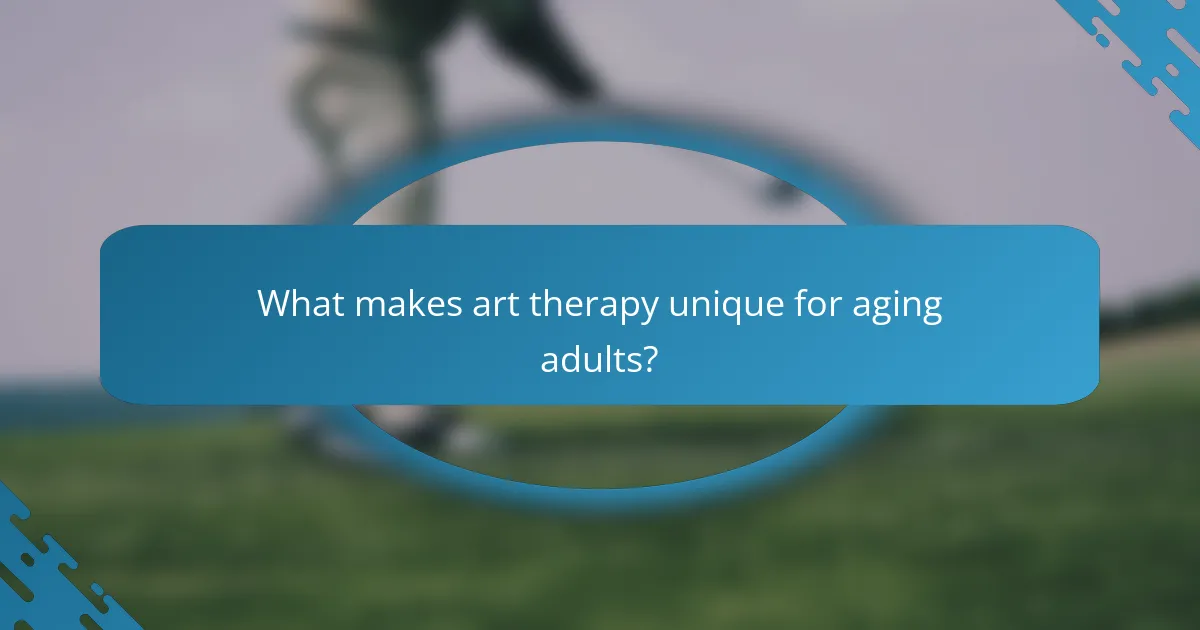Art therapy for aging adults significantly enhances emotional well-being through creative expression. It promotes social connections, reduces isolation, and includes activities like painting and drawing. Accessibility is vital, with programs tailored to accommodate various physical and cognitive abilities, ensuring inclusivity for all participants.

What is Art Therapy for Aging Adults?
Art therapy for aging adults enhances emotional well-being through creative expression. It fosters social connections and reduces feelings of isolation. Activities include painting, drawing, and sculpting, which stimulate cognitive function and promote relaxation. Accessibility is crucial; programs often adapt to varying physical and cognitive abilities, ensuring inclusivity for all participants.
How does art therapy differ from traditional therapy?
Art therapy engages creativity for emotional expression, while traditional therapy relies on verbal communication. Art therapy allows aging adults to express feelings non-verbally, fostering emotional release and connection. Traditional therapy may not accommodate those with limited verbal skills, making art therapy more accessible. Additionally, art therapy can enhance cognitive function and provide a unique form of social interaction, which is often less emphasized in traditional settings.
What are the emotional benefits of art therapy for aging adults?
Art therapy offers significant emotional benefits for aging adults, enhancing their mental well-being. It fosters self-expression, reduces feelings of isolation, and promotes emotional resilience. Engaging in creative activities can lead to improved mood and reduced anxiety, providing a therapeutic outlet for emotions. Studies indicate that art therapy can enhance cognitive functioning and memory recall, which are crucial for maintaining mental health in older adults.
How can art therapy help with depression in older adults?
Art therapy can significantly alleviate depression in older adults by providing emotional expression and connection. Engaging in creative activities fosters self-esteem and reduces feelings of isolation. Studies show that art therapy can lower depressive symptoms and enhance overall well-being. The unique attribute of art therapy is its ability to communicate feelings that may be difficult to express verbally, making it particularly effective for this demographic.
What role does creativity play in emotional well-being?
Creativity significantly enhances emotional well-being by providing a means for self-expression and stress relief. Engaging in art therapy allows aging adults to explore their feelings, improve mood, and foster social connections. This therapeutic approach can reduce symptoms of anxiety and depression, promoting a sense of purpose and fulfillment. Research shows that creative activities can activate brain regions associated with pleasure, leading to improved mental health outcomes.

What activities are commonly used in art therapy for aging adults?
Art therapy for aging adults often includes activities like painting, drawing, collage-making, and sculpture. These creative expressions promote emotional well-being and cognitive engagement. Engaging in art therapy can reduce feelings of isolation and enhance self-esteem. Additionally, activities are tailored to accommodate physical limitations, ensuring accessibility for all participants.
Which art forms are most beneficial?
Art forms such as painting, music, and dance are highly beneficial for aging adults. These activities enhance emotional well-being, stimulate cognitive functions, and promote social interaction. Engaging in artistic expression can reduce feelings of isolation and depression, fostering a sense of purpose. Additionally, art therapy is accessible, requiring minimal resources while providing significant therapeutic benefits.
How can group art therapy sessions enhance social interaction?
Group art therapy sessions significantly enhance social interaction among aging adults by fostering connection and communication. Participants engage in collaborative artistic activities, which encourage sharing and discussion. This shared creative process helps break down social barriers, promoting a sense of belonging. Research indicates that art therapy can reduce feelings of isolation, thereby improving emotional well-being. As a result, these sessions not only provide creative expression but also strengthen community ties and interpersonal relationships among participants.
What are some examples of collaborative art projects?
Collaborative art projects for aging adults can enhance emotional well-being and foster social connections. Examples include community mural painting, group pottery classes, collaborative storytelling workshops, and art exhibitions featuring contributions from multiple artists. These activities promote creativity and provide a platform for shared experiences, improving mental health and reducing feelings of isolation.
What are individual art therapy techniques for seniors?
Art therapy techniques for seniors include painting, drawing, collage, and sculpture. These activities promote emotional expression and cognitive engagement. Painting allows for free expression, while drawing can enhance fine motor skills. Collage encourages creativity through mixed media, and sculpture provides tactile interaction. Each technique can be adapted for accessibility, ensuring seniors of varying abilities can participate.
How can painting be used for self-expression?
Painting serves as a powerful tool for self-expression, particularly in art therapy for aging adults. It allows individuals to convey emotions and experiences that may be difficult to articulate verbally. Through the creative process, participants can explore feelings of nostalgia, joy, or grief, fostering emotional healing and personal insight. Engaging in painting activities enhances cognitive function and promotes social interaction, which are essential for overall well-being in later life. The accessibility of various painting mediums further encourages participation, making it a valuable resource in therapeutic settings.
What is the significance of journaling in art therapy?
Journaling in art therapy significantly enhances emotional expression and self-reflection for aging adults. It serves as a unique tool to process feelings and experiences, fostering mental well-being. Engaging in this practice can lead to improved mood and reduced anxiety. Studies indicate that expressive writing can lower stress levels, making it particularly beneficial for older adults facing life transitions. Additionally, journaling complements creative activities, enriching the therapeutic experience in art therapy settings.

What makes art therapy unique for aging adults?
Art therapy is unique for aging adults because it fosters emotional expression and cognitive engagement through creative activities. This therapeutic approach enhances mental well-being, reduces feelings of isolation, and promotes social interaction. Activities such as painting, drawing, and sculpting cater to various skill levels, making art accessible. The unique attribute of art therapy lies in its ability to adapt to individual needs, allowing personalization for each participant. Additionally, studies show that engaging in art can improve memory and cognitive function, providing rare benefits for older adults.
How does art therapy address age-related cognitive decline?
Art therapy effectively addresses age-related cognitive decline by enhancing emotional expression and cognitive engagement. It promotes creativity, which stimulates neural pathways and improves memory retention. Engaging in art activities can also reduce anxiety and depression, common in aging adults. Studies show that regular participation in art therapy can lead to improved cognitive functioning and overall well-being, making it a valuable tool for enhancing quality of life in older populations.
What unique emotional challenges do aging adults face?
Aging adults face unique emotional challenges, including isolation, loss of independence, and grief. These issues can lead to depression and anxiety. Art therapy offers a constructive outlet to express feelings, fostering emotional well-being. Engaging in creative activities helps mitigate loneliness and enhances social connections. The unique attribute of art therapy is its ability to facilitate communication without verbal expression, making it particularly beneficial for those facing cognitive decline.

What are the barriers to accessing art therapy for seniors?
Barriers to accessing art therapy for seniors include financial constraints, limited transportation options, and lack of awareness about available programs. Many aging adults face mobility issues, making it difficult to attend sessions. Additionally, some may not have insurance coverage for art therapy, limiting their ability to participate. Social isolation can further hinder access, as seniors may struggle to find companions or support to engage in these therapeutic activities.
How do financial constraints impact access to art therapy?
Financial constraints significantly limit access to art therapy for aging adults. Many individuals face challenges affording therapy sessions, which can lead to decreased emotional well-being. Research indicates that art therapy can reduce symptoms of depression and anxiety, but without financial support, many seniors miss these benefits. Community programs and sliding scale fees can improve accessibility, but funding remains a critical barrier.
What role do transportation issues play in accessibility?
Transportation issues significantly hinder accessibility for aging adults in art therapy programs. Limited transportation options can restrict attendance, impacting emotional benefits and participation in activities. For instance, inaccessible venues may prevent individuals from engaging in therapeutic art experiences, reducing their overall well-being. Addressing transportation barriers can enhance access and improve the emotional benefits derived from art therapy.

How can art therapy programs be made more accessible?
Art therapy programs can be made more accessible by incorporating community outreach, offering virtual sessions, and providing financial assistance. Expanding locations to include senior centers and libraries enhances reach. Training volunteers to facilitate sessions can also increase availability. These approaches ensure aging adults can benefit from art therapy’s emotional advantages.
What community resources are available for seniors seeking art therapy?
Art therapy resources for seniors include community centers, local art studios, and nonprofit organizations. Many offer specialized programs tailored for aging adults, focusing on emotional expression and cognitive engagement.
1. Community Centers: These often host art therapy sessions, providing a supportive environment for social interaction.
2. Local Art Studios: Some studios offer workshops specifically designed for seniors, promoting creativity and skill development.
3. Nonprofit Organizations: Various nonprofits provide access to art therapy programs, sometimes at reduced costs or free of charge.
4. Senior Living Facilities: Many facilities incorporate art therapy into their wellness programs, enhancing residents’ emotional well-being.
5. Online Platforms: Virtual art therapy sessions are increasingly available, allowing seniors to participate from home.
These resources help seniors improve mental health, reduce isolation, and foster community connections through creative expression.
How can technology facilitate remote art therapy sessions?
Technology facilitates remote art therapy sessions by providing accessible platforms for communication and creative expression. Video conferencing tools enable real-time interaction, fostering connection between therapists and aging adults. Digital art applications allow participants to create and share artwork easily, enhancing engagement. Additionally, online resources offer a variety of guided activities tailored to emotional well-being, making art therapy more inclusive and adaptable.

What are best practices for implementing art therapy for aging adults?
Art therapy for aging adults enhances emotional well-being through creative expression. Best practices include creating a safe environment, using accessible materials, and tailoring activities to individual abilities. Regular sessions foster social connections, reducing feelings of isolation. Incorporating personal interests into projects can increase engagement and motivation.
What common mistakes should be avoided in art therapy sessions?
To ensure effective art therapy sessions for aging adults, avoid these common mistakes: neglecting individual needs, failing to create a safe environment, overlooking the importance of facilitation, and not adapting activities to varying abilities. Each mistake can hinder emotional benefits and accessibility.
How can caregivers support aging adults in art therapy activities?
Caregivers can enhance art therapy for aging adults by creating a supportive environment, facilitating activities, and encouraging self-expression. They should adapt activities to suit individual abilities, ensuring accessibility and engagement.
Providing a variety of materials, such as paints, clay, and drawing tools, can stimulate creativity. Encouragement and positive feedback foster emotional well-being, reducing anxiety and promoting social interaction.
Additionally, caregivers can incorporate themes relevant to the aging adult’s life experiences, enhancing personal connection to the art. Regular participation can lead to improved cognitive function and emotional stability, making art therapy a valuable tool in caregiving.
What expert insights can enhance the effectiveness of art therapy?
Art therapy can be enhanced by expert insights that focus on individualized approaches, fostering social connections, and integrating diverse activities. Tailoring sessions to personal interests maximizes emotional benefits. Encouraging group activities promotes social interaction, reducing feelings of isolation. Additionally, incorporating various art forms, such as painting or sculpture, stimulates creativity and engagement, which are essential for emotional well-being in aging adults.